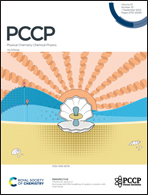Machine learning search for stable binary Sn alloys with Na, Ca, Cu, Pd, and Ag†
Abstract
We present our findings of a large-scale screening for new synthesizable materials in five M–Sn binaries, M = Na, Ca, Cu, Pd, and Ag. The focus on these systems was motivated by the known richness of M–Sn properties with potential applications in energy storage, electronics packaging, and superconductivity. For the systematic exploration of the large configuration space, we relied on our recently developed MAISE-NET framework that constructs accurate neural network interatomic potentials and utilizes them to accelerate ab initio global structure searches. The scan of over two million candidate phases at a fraction of the typical ab initio calculation cost has uncovered 29 possible intermetallics thermodynamically stable at different temperatures and pressures (1 bar and 20 GPa). Notable predictions of ambient-pressure materials include a simple hP6-NaSn2 phase, fcc-based Pd-rich alloys, tI36-PdSn2 with a new prototype, and several high-temperature Sn-rich ground states in the Na–Sn, Cu–Sn, and Ag–Sn systems. Our modeling work also involved ab initio (re)examination of previously observed M–Sn compounds that helped explain the entropy-driven stabilization of known Cu–Sn phases. The study demonstrates the benefits of guiding structure searches with machine learning potentials and significantly expands the number of predicted thermodynamically stable crystalline intermetallics achieved with this strategy so far.



 Please wait while we load your content...
Please wait while we load your content...